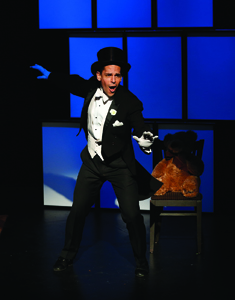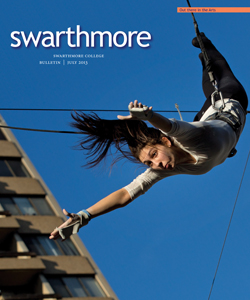The Last Show-Biz Barrier
Ike Schambelan ’61’s Troupe is the Only Off-Broadway Company Featuring Actors and Crew Members with Disabilities
Breaking through barriers has been a way of life for Ike Schambelan ’61 since his Swarthmore days as a theater-loving student who chose to live in a residence hall peopled by athletes. For the last three decades, he’s continued to break down barriers—shaking up the New York theater status quo by giving actors and stage crew with disabilities the chance to shine Off-Broadway.

Ike Schambelan ’61 runs through some details with the cast and crew of According to Goldman before a performance this spring at the Clurman Theatre on Theatre Row, a collection of renovated historic theaters near Times Square. From left: Ike Schambelan, Pamela Sabaugh, Nicholas Viselli, Stephen Drabicki, and Ann Marie Morelli. Photo by Laurence Kesterson
Schambelan began Theater By The Blind in 1980 as “a gimmick to direct.” Five years ago, he changed the company’s name to Theater Breaking Through Boundaries (TBTB) and expanded its mission to include actors with disabilities other than visual impairment. In TBTB, disabled actors work with the able-bodied. “We’re an arts organization, not a therapy organization,” Schambelan says.
Before Theater By the Blind morphed into TBTB, well-meaning patrons would contribute money but wouldn’t come to the shows. They feared they’d see visually impaired actors walking into walls or falling off the stage.
Now theatergoers come for the play and aren’t shy about asking which actors in the cast are disabled. TBTB’s latest Off-Broadway show ran in April and May at the Clurman Theatre. In Bruce Graham’s According to Goldman, the long-suffering wife, who stutters under pressure, actually is legally blind. The young film fanatic who double-crosses his Hollywood-has-been professor is hard of hearing. The actor playing the professor is able-bodied but married to the production’s stage manager, who’s in a wheelchair.
While Schambelan’s troupe remains the only Off-Broadway company featuring actors and a crew member with disabilities, he is part of a small but growing network of like-minded directors around the nation. Three new companies, one a spinoff of TBTB, recently began in the New York area.
What motivates Schambelan? “I mix groups. That’s what I do. I’m a twin. I went to a black-Jewish high school in Philadelphia. Swarthmore put me in Mary Lyon, the place for the artsy guys, but I immediately went to Wharton, the jock dorm.” As inclusive 50 years ago as it is now, Swarthmore also is where he first explored his bisexuality.
As an honors English major who minored in history and psychology, Schambelan spent most of his time at the campus theater (the discipline was not yet a major). He recalls a professor telling him, “I assume most of the bad typing on this paper is due to your show opening.”
Schambelan found his calling during junior year while directing the Hamburg Show (oh, happy memories of the annual student musical variety show). He recalls Swarthmore drama director Barbara Pearson Lange ’31 saying that when Schambelan was president of the Little Theater Club, he brought the bohemians and the jocks together.
Quite simply, Schambelan, now 73, says, “Swarthmore gave me my career.” He went on to earn a Ph.D. in fine arts from Yale School of Drama. Before starting Theater for the Blind, he spent seven years directing plays with patients and community members at Austin Riggs Center, which he describes as “a wonderful loony bin” in Stockbridge, Mass. His directing credits include Long Wharf Theatre in Boston, the Manhattan Theatre Club, and Playwrights Horizons.
TBTB, says Schambelan, is very Swarthmore—“aesthetic, humanitarian, political.” He wants the company to help change the public’s perceptions of people with disabilities and to create a theater space that is welcoming to audience members with disabilities. For instance, the visually impaired are invited to come on stage preshow to experience the set up close.
Sadly, more than 20 years after the passage of the Americans with Disabilities Act (ADA), disabled actors are still often ignored by the all-powerful image-makers in theater, TV, and film.

Stephen Drabicki, who is hard of hearing, had a leading role in According to Goldman, directed by Ike Schambelan ’61. Photo by Carol Rosegg.
Five years ago, the tri-union alliance of Actors’ Equity Association, Screen Actors Guild, and American Federation of Television and Radio Artists (SAG and AFTRA have since merged) took action, launching a three-year campaign to push the entertainment industry toward authentic casting—featuring characters with disabilities acted by performers with disabilities and authentic story lines depicting disabled characters in more than heart-wrenching stereotypes. Through Inclusion in the Arts and Media of People With Disabilities (I AM PWD), the effort continues, but the track record remains dismal.
A painstaking study by Gay & Lesbian Alliance Against Defamation (GLAAD) documented that only five of the 647 regular characters in scripted series on network television’s prime-time 2011–12 season were disabled. That’s less than 1 percent. With more than 18 percent of the population with some kind of disability (that’s 56.7 million noninstitutionalized Americans, according to ADA 2010 statistics) this does not reflect life in these United States.
“Actors have sought legal action, but we don’t see it often because of that fear of retribution or retaliation,” says Adam Moore, SAG-AFTRA national director of equal opportunity and diversity. Even behind closed doors, “a lot of the time members aren’t forthcoming. They’re afraid somehow the walls have ears, even [when] talking to SAG-AFTRA confidentially.”
Christine Bruno, disability advocate with the Alliance for Inclusion in the Arts and 2011 co-chair of the I AM PWD global civil-rights campaign, says, “The public is very accepting” of characters with disabilities. She has seen some changes in film and TV, as soldiers return from Afghanistan and Iraq as amputees and in wheelchairs but fewer in theater. “There’s a tremendous increase in story lines, and people want to get it right. Our industry is embracing the fact that we can tell those stories authentically.”
One issue for producers like Schambelan is the added expense of hiring actors with disabilities. TBTB’s Nicholas Viselli, a longtime company member who played the professor in According to Goldman, praises Schambelan for paying the price, which includes the cost of backstage ramps and special sound systems. While theaters must accommodate patrons with disabilities, when it comes to disabled actors, the ADA can be ignored.

From left: Nicholas Viselli, Stephen Drabicki, and Pamela Sabaugh in Bruce Graham’s According To Goldman, a Theater Breaking Through Boundaries production this spring. Photo by Carol Rosegg.
Viselli’s wife, Ann Marie Morelli, has the unenviable distinction of being the one member of TBTB to go from able-bodied to disabled, as multiple sclerosis gradually confined her to a wheelchair. When she was stage managing one show on New York’s Theatre Row, her husband had to carry her over his shoulder up the steep flight of stairs to the production booth. “I felt like a prisoner in the tower,” she says.
For TBTB’s 2007 production of Midsummer Night’s Dream, Morelli appeared on stage—in four roles, with the help of a ramp built specially for her. The New York Times applauded the extra layer of meaning when Shakespeare’s Hermia, ridiculed for being short, laments from her wheelchair, “My legs can keep no pace with my desires.”
Leo Braudy ’63, cultural historian, film critic, and professor of English and American literature at the University of Southern California, has been a TBTB supporter for years.
Braudy, who’s known Schambelan since junior high school, says, “I’m sure Ike has struggled with the conundrum of trying to change attitudes toward actors with disabilities. You want to create a performance in which the disability doesn’t matter, but you also want the audience to realize that the disability doesn’t matter.”
Theatergoers may no longer worry that blind actors will fall off the stage, but Director Schambelan can still be anxious. As he expands his cast of disabled actors, he says, “I still feel nervous dealing with a disability that I haven’t dealt with before.”
His approach is to keep breaking through barriers. If grants come through, in October TBTB’s Pamela Sabaugh, the sight-impaired actor who played the professor’s wife in According to Goldman, will direct a cast of blind actors at the International Blind and Visually Impaired Theater Festival in Croatia.
 Email This Page
Email This Page